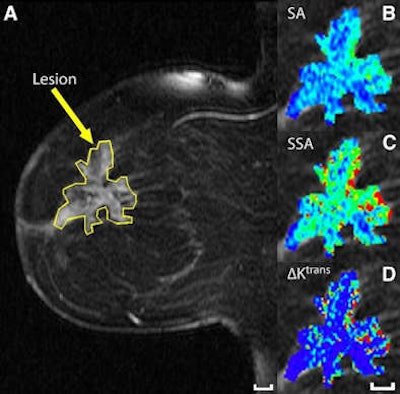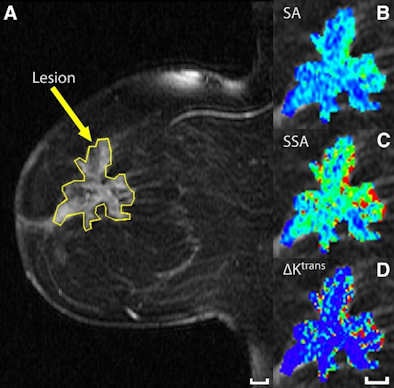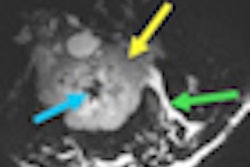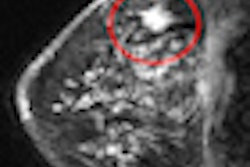
Researchers at Oregon Health & Science University (OHSU) are using a technique called shutter-speed dynamic contrast-enhanced MRI to improve breast cancer diagnostic accuracy and reduce unnecessary biopsies, according to a study published online August 9 by Radiology.
In the study sample of 92 tumors that were negative on mammography but visible on MRI, the shutter-speed MRI approach achieved sensitivity of 100% and specificity of 86%, compared with 78% specificity for standard contract-enhanced MRI approaches.
Lead study author is Wei Huang, PhD, from OHSU's W. M. Keck Foundation High-Field MRI Laboratory-Advanced Imaging Research Center and Knight Cancer Institute in Portand.
Monitoring water movement
The shutter-speed MRI technique monitors the movement of water molecules in diseased and healthy tissue. By varying shutter speed, the movement of the molecules can be slowed to better view the location of tumors and help determine if they are malignant or benign.
Researchers enrolled high-risk breast cancer patients between February 2007 and April 2009 who received semiannual or annual MRI exams due, in part, to a family history of breast cancer.
A total of 89 women with a mean age of 52 years, ranging from 28 to 83 years, were recruited for the study. Each woman received a dynamic contrast-enhanced 1.5-tesla MRI scan (Excite, GE Healthcare) of the breast with the suspicious lesion or lesions prior to a clinical MRI-guided biopsy. The contrast agent gadopentetate dimeglumine (Magnevist, Bayer HealthCare Pharmaceuticals) was administered intravenously at 0.1 mmol/kg of body weight.
Biopsy pathologic findings were used to assess diagnostic accuracy of dynamic contrast-enhanced MRI results.
 |
| MR image of a 57-year-old woman with invasive lobular carcinoma (A), which shows the contrast-enhanced lesion. The pixel-by-pixel color maps within the region of interest were generated by using the standard approach (B) and shutter-speed approach (C) and overlaid onto the anatomic image (D). The shutter-speed approach and maps show numerous hot spots, mostly in the posterior tumor rim region. Image courtesy of Radiology. |
Researchers found 92 suspicious breast lesions using 1.5-tesla MRI that were deemed negative via mammography. Of these, 83 lesions were classified as suspicious (BI-RADS 4; 38 masses, 34 nonmasses, and 11 focus enhancements) and nine lesions considered highly suggestive of malignancy (BI-RADS 5, seven masses and two nonmasses). The median tumor diameter was 7.5 mm, ranging from 3 to 16.6 mm for 91 lesions.
Lesion analysis
The study's pathological analysis found 20 lesions (12 BI-RADS 4 masses and eight BI-RADS 5 masses) that were malignant and 72 lesions (71 BI-RADS 4 masses and one BI-RADS 5 mass) that were benign.
The results for biopsy achieved a positive predictive value of 22% (20 of 92 tumors), with the diameters of the malignant lesions (mean of 10.6 mm) not statistically different (p = 0.25) than those of the benign lesions (mean of 8.0 mm).
Researchers also found that with 100% sensitivity, the shutter-speed approach, when averaged for specific regions of interests, reached greater diagnostic specificity of 86%, compared with 78% for standard MR imaging techniques (p = 0.008).
In addtion, Huang and colleagues noted, with the exception of one benign tubular adenoma identified as malignant, the remaining 91 lesions were correctly classified by combining regions of interest and pixel-by-pixel mapping with a histographic analysis approach to improve diagnostic accuracy to 98.6% specificity (71 of 72) at 100% sensitivity.
Due to the greater accuracy of its findings, Huang and colleagues opined that the shutter-speed contrast-enhanced MRI technique may reduce "unnecessary biopsies that yield benign pathologic findings."
One limitation cited by the authors was the study population itself, which included high-risk patients with negative findings at mammography who were referred for an MRI scan, rather than a biopsy. That variable may have biased results, they wrote.




















